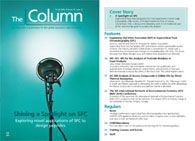A Spotlight on SFC
A Spotlight on SFC
Supercritical fluid chromatography (SFC) has experienced a recent increase in popularity. Gilles Goetz, a Principal Scientist at Pfizer in Groton, Connecticut, USA, is doing some interesting work in non-traditional uses of SFC. He recently spoke to us about this research.
Photo Credit: Tom Fullum/Getty Images

Q. Supercritical fluid chromatography (SFC) seems to be back in fashion again. Why is this?
A: I think one of the main reasons supercritical fluid chromatography (SFC) has recently enjoyed a surge in popularity is because of the “green chemistry” attributes. First of all, the use of CO2 in SFC operation is carbon neutral. Compared to high performance liquid chromatography (HPLC), SFC uses much less organic solvents, reducing the cost of operation, processing (evaporating), and disposal. SFC offers a significant reduction in chemical waste, making it a more environmentally friendly alternative to HPLC. Health and safety benefits are obvious results of organic solvents reduction.
Instrument manufacturers have also realized this as well. Recent mergers and acquisitions amongst them have brought SFC into the mainstream of analytical separation techniques. SFC now benefits from the same extensive marketing and sales networks as HPLC.
In our purification laboratory, SFC has the upper hand over HPLC. SFC is used for over 90% of the chiral purifications and for about 50% of the achiral purifications. Because there is no diffusion occurring in SFC, resolution and speed are significantly improved.
Q. How has SFC evolved and has the technique tackled some of the problems associated with it in the past?
A: The first commercially available SFC system dates back to 1982. In the early days, capillary SFC and packed column SFC co-evolved and competed with each other. Capillary SFC lost ground and eventually faded away, mainly as a result of poor reproducibility issues. The early systems were costly and not user friendly, resulting in the technique being marginalized as too expensive and inefficient.
The main obstacles to the adoption of SFC have been the high pressure operating conditions, the difficulty to maintain those high pressures consistently, and the handling of the depressurization and aerosolization issues post analysis.
Current benchtop analytical systems are able to function with a simple high purity CO
2
cylinder. More complex operations (that is, purification laboratories) require larger volumes of CO
2
, typically stored as liquid in a centralized location before being distributed, and converted into supercritical fluid in the SFC instrument. Improvement in back pressure regulator technology enabled constant pressures across SFC systems even during gradient elution, when solvent compositions or flow rates change. In the realm of preparative SFC, full recovery of product upon collection is paramount. The development of effective gas/liquids separators (such as the cyclone separators) enabled CO
2
to depressurize without aerosolizing and losing the dissolved product, keeping it safe to collect with the co-solvent portion of the eluent.
Q. Are there any new trends or discoveries using “modern” SFC?
A:
Ultrahigh-performance SFC (UHPSFC) and the combination of a new generation of instrumentation (more robust, reliable and with improved performance) with sub-2-μm particles columns appears to be quite the hype these days. Reliability, robustness, and performances are improved with this combination; for example, core–shell 2.6 μm columns showed a 50% increase in efficiency compared to 3 μm fully porous particles. Expanding the chemical space of compounds amenable to both chiral and achiral SFC has recently been the focus of significant efforts. Methods are being developed to accommodate highly polar or ionic compounds historically incompatible with SFC. (Larry Taylor at VT is working on peptide analyses using ion pairing SFC, with mobile phases consisting of CO
2
, 5% v/v of water in methanol containing an ion pairing agent).
Q. How easy is it to implement SFC in your work?
A:
Because of the perception of danger associated with operating under special conditions (high pressure and high temperature) that actually change the state of the matter of the CO
2
into something quite mysterious (a supercritical fluid), SFC might be perceived as intimidating and complicated to neophytes. This is a common misconception. Implementing SFC is pretty much plug and play. This was the case for this work as well. SFC was the method of choice to get us to analysis conditions with a dielectric constant mimicking the inside of a biological membrane, in my opinion, much more so than normal phase HPLC.
Q. What is the appeal of SFC in pharmaceutical analysis? How can you use SFC to enable drug design?
A:
In the pharmaceutical industry, emphasis is placed on return on investment. The many advantages of SFC in terms of analysis speed, improved resolution, and solvent consumption compensate for the original infrastructure investment needed for efficient SFC operation. As green highâthroughput pharmaceutical analysis goes, SFC is the ultimate contender, and the same is true for preparative-scale chiral purifications. Indeed, by enabling separation of enantiomers in a new chemical space previously limited by normal phase chiral HPLC, SFC reduced the need for complex and expensive asymmetric syntheses in early project development. Applications of SFC in the pharmaceutical industry are not limited to sample purity analysis, chiral enantiomer excess determinations, or fast chiral and achiral purification from milligram to multi-gram scales. With the introduction of EPSA - a novel SFC technique enabling the design of permeable cyclic peptides - we enabled SFC to enter the realm of drug design. With EPSA we are able, using a pairwise analysis, to confirm or disprove the presence of an intramolecular hydrogen bound (IMHB) in small molecules or peptides. These IMHBs are a critical factor affecting the conformation of molecules and can have a direct impact on their absorption into the human body, their permeability into target cells, and even their potency against therapeutic targets. Having a reproducible, rugged, high-throughput method able to highlight those conformation changes can be a game changer in terms of drug design.
Q. You are doing some interesting work in non-traditional uses of SFC. Please can you detail the reasons behind the development of EPSA.
A:
The identification of compounds likely to form intramolecular hydrogen bonds is an important drug design consideration given the correlation of intramolecular hydrogen bonding with increased membrane permeability. Having access to a fast, robust method to identify the potential for a compound to form IMHBs and as a result hide polarity that might otherwise reduce the permeability of the compound was the main idea behind EPSA. Once we successfully established EPSA as a viable polarity monitoring tool for small molecules, we went on to tackle peptides, especially cyclic peptides, which generally demonstrate insufficient permeability to be used as oral drugs. Guiding the design of such peptides without a reliable permeability monitoring method is a challenge. Since for peptides, the main obstacle to permeability is polarity, the EPSA experiment was a perfect fit. We now routinely use EPSA data to inform peptide design as a predictor of permeability and an indicator of IMHB patterns in cyclic peptides.
Q. Please can you describe EPSA. Could this technique be applied to other applications, other than pharmaceuticals?
A:
Our method named EPSA provides, under controlled SFC conditions, an exposed/hidden polarity readout that is derived from the retention time of a compound on a specific column. The stationary phase was selected for its balance of lipophilic and polar attributes and its capacity to separate compounds with wide polarity differences. SFC, which uses inherently normal phase conditions, provides a low dielectric constant environment conducive to IMHB formation. Polar compounds are retained stronger under these conditions, and a low-slope gradient of methanol achieves elution based on increasing polarity of the mobile phase. In the cases that we have studied, using matched molecular pairs with or without IMHBs, compounds with IMHB resulted in a significant reduction in polarity and eluted earlier in the chromatogram. Results are normalized daily by the use of calibration standards generating a linear relationship between retention times and EPSA values. This method has been successfully used for small molecule medicinal chemistry projects to assess exposed polarities of their lead compounds. Having spent my entire career in pharmaceutical R&D, I am probably excessively pharma-centric, so I have not yet seriously considered other applications. But I believe that any field where the polarity monitoring of chemicals has any significance can benefit from EPSA, provided that the compounds are compatible with the SFC solvent system. This means that the experiment need not be limited to the pharmaceutical industry.
Q. Where do you hope your research with EPSA will take you in the future?
A:
There are still a few things that I would like to figure out about EPSA. For example, the complete recognition mechanism between the stationary phase and the polar analytes and the contribution of fully charged species on retention, notably why specific carboxylic acids behave as if they are more polar than expected.

Gilles Goetz
is a Principal Scientist at Pfizer in Groton, Connecticut, USA. Gilles received his B.Sc. (chemistry/biochemistry 1991) and Ph.D. (organic chemistry 1995) at the University of Strasbourg in France, studying the molecular processes of poison ivy contact dermatitis. After two post docs at the University of Hawaii (1996–97) studying marine natural products and the University of Neuchatel (CH) (1998–99) focusing on secondary metabolites from fungal and terrestrial sources, he joined Monsanto in 2000. There he worked through mergers and acquisitions for Pharmacia and Pfizer successively in the Natural Product group, the High Throughput Screening group (analytical support), and the Automated Purification Group. In 2010 he transferred to the Expert Purification Group at Pfizer Groton and in 2011 became a member of the Molecular Properties Group. He is part of the team tasked with influencing medicinal chemistry design teams through insights into molecular properties such as polarity, lipophilicity, shape, and conformation that will impact molecular behaviours such as solubility, permeability, and efflux. They develop and use mainly chromatographic techniques (EPSA) to assess those properties, and work towards predicting molecular behaviours.

The Next Frontier for Mass Spectrometry: Maximizing Ion Utilization
January 20th 2025In this podcast, Daniel DeBord, CTO of MOBILion Systems, describes a new high resolution mass spectrometry approach that promises to increase speed and sensitivity in omics applications. MOBILion recently introduced the PAMAF mode of operation, which stands for parallel accumulation with mobility aligned fragmentation. It substantially increases the fraction of ions used for mass spectrometry analysis by replacing the functionality of the quadrupole with high resolution ion mobility. Listen to learn more about this exciting new development.
Liquid Chromatography to Analyze Vitamin D Proteins in Psoriasis Patients
January 21st 2025Can a protein involved in delivering Vitamin D to target tissues have an altered serum profile in psoriasis patients with cardiovascular disease? Researchers used liquid chromatography (LC) to help find out.
The Complexity of Oligonucleotide Separations
January 9th 2025Peter Pellegrinelli, Applications Specialist at Advanced Materials Technology (AMT) explains the complexity of oligonucleotide separations due to the unique chemical properties of these molecules. Issues such as varying length, sequence complexity, and hydrophilic-hydrophobic characteristics make efficient separations difficult. Separation scientists are addressing these challenges by modifying mobile phase compositions, using varying ion-pairing reagents, and exploring alternative separation modes like HILIC and ion-exchange chromatography. Due to these complexities, AMT has introduced the HALO® OLIGO column, which offers high-resolution, fast separations through its innovative Fused-Core® technology and high pH stability. Alongside explaining the new column, Peter looks to the future of these separations and what is next to come.
A Guide To Finding the Ideal Syringe and Needle
January 20th 2025Hamilton has produced a series of reference guides to assist science professionals in finding the best-suited products and configurations for their applications. The Syringe and Needle Reference Guide provides detailed information on Hamilton Company’s full portfolio of syringes and needles. Everything from cleaning and preventative maintenance to individual part numbers are available for review. It also includes selection charts to help you choose between syringe terminations like cemented needles and luer tips.